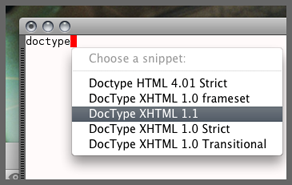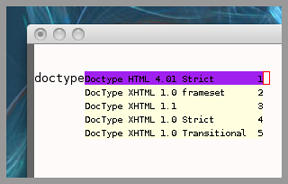Expanding snippets
Table of Contents
This section describes how YASnippet chooses snippets for expansion at point.
Maybe, you'll want some snippets to be expanded in a particular mode, or only under certain conditions, or be prompted using
Triggering expansion
You can use YASnippet to expand snippets in different ways:
- When
yas-minor-modeis active:- Type the snippet's trigger key then calling
yas-expand(bound toTABby default). - Use the snippet's keybinding.
- By expanding directly from the "YASnippet" menu in the menu-bar
- Using hippie-expand
- Type the snippet's trigger key then calling
- Call
yas-insert-snippet(useM-x yas-insert-snippetor its keybindingC-c & C-s). - Use m2m's excellent auto-complete TODO: example for this
- Expanding from emacs-lisp code
Trigger key
yas-expand tries to expand a snippet abbrev (also known as
snippet key) before point. YASnippet also provides a conditional
binding for this command: the variable yas-maybe-expand contains a
special value which, when bound in a keymap, tells Emacs to call
yas-expand if and only if there is a snippet abbrev before point.
If there is no snippet to expand, Emacs will behave as if yas-expand
is unbound and so will run whatever command is bound to that key
normally.
When yas-minor-mode is enabled, it binds yas-maybe-expand to TAB
and <tab> by default, however, you can freely remove those bindings:
(define-key yas-minor-mode-map (kbd "<tab>") nil) (define-key yas-minor-mode-map (kbd "TAB") nil)
And set your own:
;; Bind `SPC' to `yas-expand' when snippet expansion available (it ;; will still call `self-insert-command' otherwise). (define-key yas-minor-mode-map (kbd "SPC") yas-maybe-expand) ;; Bind `C-c y' to `yas-expand' ONLY. (define-key yas-minor-mode-map (kbd "C-c y") #'yas-expand)
To enable the YASnippet minor mode in all buffers globally use the
command yas-global-mode. This will enable a modeline indicator,
yas:

When you use yas-global-mode you can also selectively disable
YASnippet in some buffers by calling yas-minor-mode with a negative
argument in the buffer's mode hook.
Fallback behaviour
YASnippet used to support a more complicated way of sharing
keybindings before yas-maybe-expand was added. This is now
obsolete.
Insert at point
The command yas-insert-snippet lets you insert snippets at point
for your current major mode. It prompts you for the snippet key
first, and then for a snippet template if more than one template
exists for the same key.
The list presented contains the snippets that can be inserted at point,
according to the condition system. If you want to see all applicable
snippets for the major mode, prefix this command with C-u.
The prompting methods used are again controlled by
yas-prompt-functions.
Inserting region or register contents into snippet
It's often useful to inject already written text in the middle of a
snippet. The variable yas-wrap-around-region when to t substitute
the region contents into the $0 placeholder of a snippet expanded by
yas-insert-snippet. Setting it to a character value (e.g. ?0)
will insert the contents of corresponding register.
Older (versions 0.9.1 and below) of Yasnippet, supported a setting of
cua that is equivalent to ?0 but only worked with cua-mode
turned on. This setting is still supported for backwards
compatibility, but is now entirely equivalent to ?0.
Snippet keybinding
See the section of the # binding: directive in
Writing Snippets.
Expanding from the menu
See the YASnippet Menu.
Expanding with hippie-expand
To integrate with hippie-expand, just put
yas-hippie-try-expand in
hippie-expand-try-functions-list. This probably makes more sense
when placed at the top of the list, but it can be put anywhere you
prefer.
Expanding from emacs-lisp code
Sometimes you might want to expand a snippet directly from your own
elisp code. You should call yas-expand-snippet instead of
yas-expand in this case. yas-expand-snippet takes a string in
snippet template syntax, if you want to expand an existing snippet you
can use yas-lookup-snippet to find its contents by name.
As with expanding from the menubar, the condition system and multiple
candidates doesn't affect expansion (the condition system does affect
yas-lookup-snippet though). In fact, expanding from the YASnippet
menu has the same effect of evaluating the follow code:
(yas-expand-snippet template)
See the internal documentation on yas-expand-snippet and
yas-lookup-snippet for more information.
Controlling expansion
Eligible snippets
YASnippet does quite a bit of filtering to find out which snippets are eligible for expanding at the current cursor position.
In particular, the following things matter:
Currently loaded snippets tables
These are loaded from a directory hierarchy in your file system. See Organizing Snippets. They are named after major modes like
html-mode,ruby-mode, etc…Major mode of the current buffer
If the currrent major mode matches one of the loaded snippet tables, then all that table's snippets are considered for expansion. Use
M-x describe-variable RET major-mode RETto find out which major mode you are in currently.Parent tables
Snippet tables defined as the parent of some other eligible table are also considered. This works recursively, i.e. parents of parents of eligible tables are also considered.
Buffer-local list of extra modes
Use
yas-activate-extra-modeto consider snippet tables whose name does not correspond to a major mode. Typically, you call this from a minor mode hook, for example:
;; When entering rinari-minor-mode, consider also the snippets in the ;; snippet table "rails-mode" (add-hook 'rinari-minor-mode-hook #'(lambda () (yas-activate-extra-mode 'rails-mode)))
Buffer-local
yas-buffer-local-conditionvariableThis variable provides finer grained control over what snippets can be expanded in the current buffer. For example, the constant
yas-not-string-or-comment-conditionhas a value that disables snippet expansion inside comments or string literals. See the condition system for more info.
The condition system
Consider this scenario: you are an old Emacs hacker. You like the
abbrev-way and bind yas-expand to SPC. However, you don't want
if to be expanded as a snippet when you are typing in a comment
block or a string (e.g. in python-mode).
If you use the # condition : directive (see Writing Snippets) you
could just specify the condition for if to be (not
(python-syntax-comment-or-string-p)). But how about while, for,
etc? Writing the same condition for all the snippets is just boring.
So you can instead set yas-buffer-local-condition to (not
(python-syntax-comment-or-string-p)) in python-mode-hook.
Then, what if you really want some particular snippet to expand even
inside a comment? Set yas-buffer-local-condition like this
(add-hook 'python-mode-hook
(lambda ()
(setq yas-buffer-local-condition
'(if (python-syntax-comment-or-string-p)
'(require-snippet-condition . force-in-comment)
t))))
… and for a snippet that you want to expand in comments, specify a
condition which evaluates to the symbol force-in-comment. Then it
can be expanded as you expected, while other snippets like if still
can't expanded in comments.
For the full set of possible conditions, see the documentation for
yas-buffer-local-condition.
Multiples snippet with the same key
The rules outlined above can return more than one snippet to be expanded at point.
When there are multiple candidates, YASnippet will let you select one.
The UI for selecting multiple candidate can be customized through
yas-prompt-functions , which defines your preferred methods of being
prompted for snippets.
You can customize it with
M-x customize-variable RET yas-prompt-functions RET. Alternatively you
can put in your emacs-file:
(setq yas-prompt-functions '(yas-x-prompt yas-dropdown-prompt))
Currently there are some alternatives solution with YASnippet.
Use the X window system

The function yas-x-prompt can be used to show a popup menu for you to
select. This menu will be part of you native window system widget, which
means:
- It usually looks beautiful. E.g. when you compile Emacs with gtk support, this menu will be rendered with your gtk theme.
- Your window system may or may not allow to you use
C-n,C-pto navigate this menu. - This function can't be used when in a terminal.
Minibuffer prompting

You can use functions yas-completing-prompt for the classic emacs
completion method or yas-ido-prompt for a much nicer looking method.
The best way is to try it. This works in a terminal.
Use dropdown-menu.el

The function yas-dropdown-prompt can also be placed in the
yas-prompt-functions list.
This works in both window system and terminal and is customizable, you
can use C-n, C-p to navigate, q to quit and even press 6 as a
shortcut to select the 6th candidate.
Roll your own
See the documentation on variable yas-prompt-functions